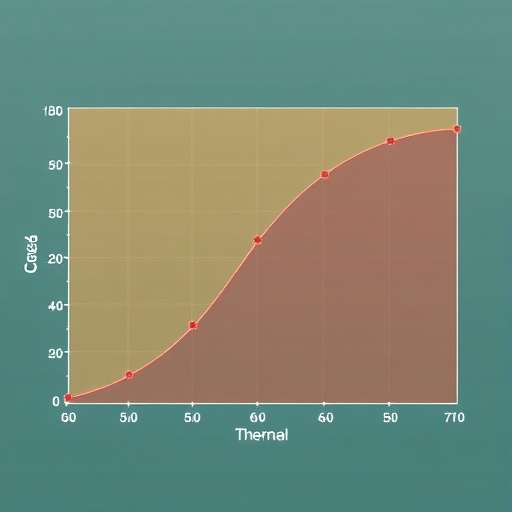In a groundbreaking discovery that is reshaping our understanding of how life operates across varying temperatures, researchers at Trinity College Dublin have unveiled a remarkable phenomenon they term the “Universal Thermal Performance Curve” (UTPC). This unifying curve encapsulates the temperature-dependent performance patterns observed across the vast diversity of life forms on Earth—from single-celled bacteria to complex vertebrates like lizards and sharks. The implications of this discovery stretch far beyond ecology and evolutionary biology, touching on critical issues such as species adaptability in the face of accelerating climate change.
Life, in its myriad forms, is profoundly influenced by temperature. Yet, before this research, the scientific community grappled with disparate models, each attempting to explain how different species function across thermal gradients. The UTPC, however, elegantly merges thousands of these disparate curves into a singular, cohesive model. It describes how an organism’s performance—whether measured by metabolic rate, reproductive success, or locomotion—responds predictably to changes in ambient temperature. This universality underscores a fundamental physiological and evolutionary constraint that life, despite billions of years of diversification, has yet to overcome.
At the heart of the UTPC is a consistent pattern observable across all taxa: performance initially rises with temperature, reaching an optimum point where physiological processes peak in efficiency. Beyond this optimum, however, performance plunges rapidly, a precipitous decline that signals the onset of stress, dysfunction, and eventually, mortality. This stark inflection point reveals the fragile balance organisms maintain with their thermal environments. The shape of this curve is not just a statistical artifact but represents real biochemical and cellular limitations, such as enzyme denaturation and membrane integrity breakdown under heat stress.
Professor Andrew Jackson, a leading zoologist involved in this study, emphasizes that while the optimal temperature for performance varies drastically—from as low as 5 degrees Celsius in some species to nearly 100 degrees Celsius in others—the fundamental curve’s shape remains invariant. This constancy suggests a deep evolutionary constraint: no matter how diverse life is, the thermal performance landscape it inhabits is remarkably uniform. Different species have not developed fundamentally different biochemical responses to temperature; rather, they have shifted the curve along the temperature axis to align with their respective ecological niches.
This discovery was made possible by synthesizing and reanalyzing over 2,500 thermal performance curves, encompassing an unprecedented range of species and experimental conditions. Dr. Nicholas Payne, a senior researcher on the team, notes that such comprehensive data integration allowed them to detect this universal pattern. From bacteria critical to global biogeochemical cycles to reptiles that serve as ecological indicators, the UTPC applies, challenging prior assumptions that each organism’s temperature response was idiosyncratic and species-specific.
Technically, the UTPC requires only two parameters to accurately describe thermal performance across species: the optimal temperature (where peak performance occurs) and the critical maximum temperature (beyond which survival is impossible). This simplicity belies the complex interplay of molecular dynamics, metabolic pathways, and evolutionary pressures driving thermal adaptation. The observed linkage between these two parameters constrains the thermal niche width organisms can occupy, highlighting evolutionary “shackles” that limit thermal adaptability.
The implications for understanding climate change vulnerability are profound. As global temperatures rise, many species will be pushed beyond their thermal optimum into ranges where performance rapidly declines, potentially leading to widespread physiological failure and increased mortality rates. The UTPC indicates that species cannot indefinitely extend their thermal tolerance via evolutionary adaptation due to these inherent constraints. This finding calls for a reevaluation of resilience models and conservation strategies under warming scenarios.
Moreover, the universality of the UTPC invites a deeper inquiry into exceptions. The research team plans to identify any species or biological systems that might deviate from this curve. Such outliers could reveal novel biochemical or physiological mechanisms of thermal adaptation, offering insights into potential pathways for mitigating climate impacts. Understanding why and how certain life forms break free of these universal constraints could revolutionize evolutionary biology and climate adaptation science.
The discovery also provides a powerful predictive framework for ecologists and climate scientists. By mapping the thermal performance curves of species onto projected climate models, it becomes possible to forecast potential shifts in species distributions, ecosystem dynamics, and biodiversity hotspots with greater accuracy. Such models are crucial for informing policy, habitat management, and biodiversity conservation efforts in a rapidly warming world.
In addition to ecological and evolutionary insights, the UTPC enhances our comprehension of fundamental biological processes. Since thermal performance is intertwined with metabolic reactions, enzyme kinetics, and cellular resilience, the universality of the curve may reflect underlying biochemical constants dictated by thermodynamics and molecular stability. This nexus between macroecological patterns and molecular biology underlines the interdisciplinary nature of the discovery.
The publication of this work in the prestigious Proceedings of the National Academy of Sciences cements its importance within the scientific community. It represents a milestone in thermal ecology by providing a parsimonious yet robust framework that unites diverse biological data. The elegant universality of the UTPC challenges researchers to rethink the limits of life’s adaptability and to explore innovative questions about thermal biology and evolution.
As humanity confronts unprecedented climate upheavals, insights like those offered by the Universal Thermal Performance Curve are not just academic—they are essential for informing how we predict, manage, and mitigate the biological impacts of our changing planet. The UTPC is a testament to the power of large-scale data synthesis and interdisciplinary collaboration in unraveling the complexities of life’s interactions with the environment.
Subject of Research: Universal Thermal Performance Curve and its implications on species’ temperature-dependent performance and adaptation limits.
Article Title: Universal Thermal Performance Curve Governs All Life’s Response to Temperature Variation
News Publication Date: Not specified in the source text.
Web References:
References: Research published in Proceedings of the National Academy of Sciences (PNAS).
Image Credits: Prof. Andrew Jackson, Trinity College Dublin
Keywords: Thermal performance curve, universal biology, temperature adaptation, climate change, species performance, evolutionary constraints, thermal niche, physiological limits




